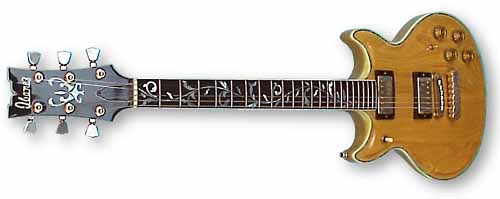
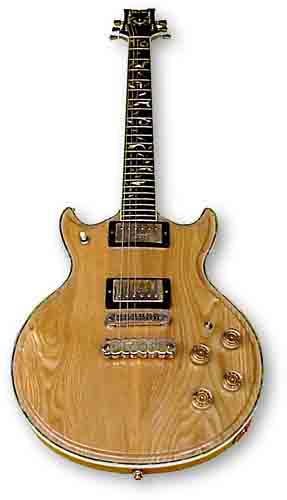
Take one Ash Artist (model 2617), one Randy Scruggs Professional (model 2671), put them into a guitar blender and push the button. What do you get? Answer: a beautiful hybrid guitar... with no name! Well, the good luthiers at Ibanez were nice enough to give it a number. Meet model 2672.
This "natural" beauty is one of Ibanez's best kept secrets and so it certainly deserves to be dubbed a truly rare guitar.
The proud owner of this sterling specimen is player and collector, Harold Wherry. Mr. Wherry has owned over 40 Ibanez guitars (his current collection contains 30 guitars). Yet, this is the only model 2672 he has ever seen.
There's not a lot of published information, but here's the specifications known about this fine guitar (the list price was gleaned from a '77-'78 price list):
- Solid Ash body
- Ebony fingerboard with vine of life inlay
- 2-Super 70 pickups with "Ibanez" embossed on the covers
- Gold Hardware
- German carve edges and abalone binding
- Fancy engraved artistic tail piece
- Controls: 2 Volume, 2 Tone, mini-toggle for Phase on Bridge pickup
- Scale 24.75"
- List price in '77-'78: $595.00 (US)
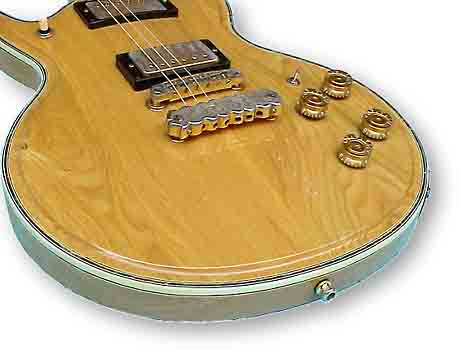
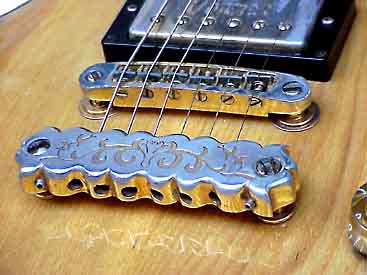 This
closeup gives you a nice look at the detail of the gold plated
bridge and fancy tail piece. This style tail piece is a definite
connection to the Randy Scruggs. You'll also remember it from
the stunning model 2674
previously showcased in Guitar Tours. Surprisingly, this tail
piece found it's way onto a few Les Paul replicas, circa '77-'78...some
of these models have half vines on the fingerboard.
This
closeup gives you a nice look at the detail of the gold plated
bridge and fancy tail piece. This style tail piece is a definite
connection to the Randy Scruggs. You'll also remember it from
the stunning model 2674
previously showcased in Guitar Tours. Surprisingly, this tail
piece found it's way onto a few Les Paul replicas, circa '77-'78...some
of these models have half vines on the fingerboard.
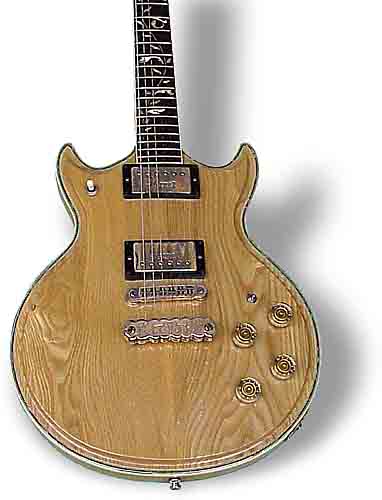 The
pickups, bridge and tail piece sit on the highest part of the
arched ash top. The contour rolls gently down toward the german
carve edge, which gives this guitar a "bi-level" look.
One of the nicest cosmetic touches is the wide strip of abalone,
sandwiched between alternating black and white binding, that
runs around the entire perimeter of the top.
The
pickups, bridge and tail piece sit on the highest part of the
arched ash top. The contour rolls gently down toward the german
carve edge, which gives this guitar a "bi-level" look.
One of the nicest cosmetic touches is the wide strip of abalone,
sandwiched between alternating black and white binding, that
runs around the entire perimeter of the top.
The transparent/gold knobs and 3-way toggle are standard issue for dual volume, dual tone, dual humbucker Artists. It's the addition of the mini-toggle switch that tells you there's something different inside the control cavity. This phase switch, connected to the bridge pickup, was one of Ibanez's first ventures into advance circuitry. This was the precursor to the highly successful Tri-sound circuit that first appeared on the model 2619 Artist.
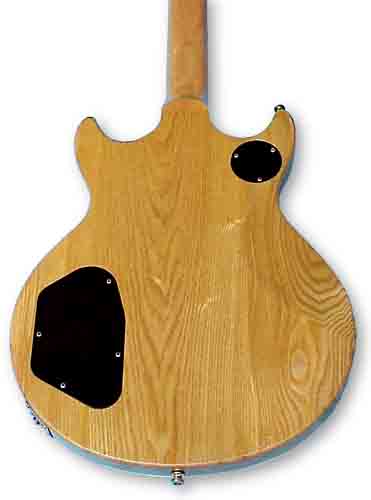 From
the back the 2672 looks just like any standard Ash Artist.
The symmetrical double-cutaway is a simple and elegant design.
The body's figured ash and the neck's maple are a perfect combination.
You'll note that this guitar does not have the "smooth-heel"
neck joint that typifies solid body Artist guitars from the late
'77 through early '79 period.
From
the back the 2672 looks just like any standard Ash Artist.
The symmetrical double-cutaway is a simple and elegant design.
The body's figured ash and the neck's maple are a perfect combination.
You'll note that this guitar does not have the "smooth-heel"
neck joint that typifies solid body Artist guitars from the late
'77 through early '79 period.
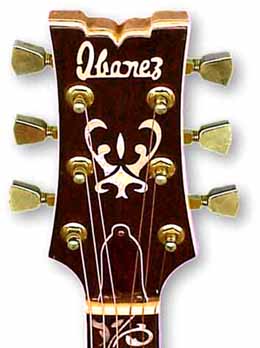 The
headstock of the 2672 is the early "castle"
design. This shape eventually found its way onto every Artist
solid and semi-hollow body guitar, as well as a few acoustics
and even some jazz boxes. At some point, (approx. 1987) the width
at the end was narrowed, giving the headstock a more tapered
appearance.
The
headstock of the 2672 is the early "castle"
design. This shape eventually found its way onto every Artist
solid and semi-hollow body guitar, as well as a few acoustics
and even some jazz boxes. At some point, (approx. 1987) the width
at the end was narrowed, giving the headstock a more tapered
appearance.
Note the script-style Ibanez logo. This logo design was standard on all Ibanezes in the early to mid '70s, but appears to have been in use on some post lawsuit LPs as late as 1978.
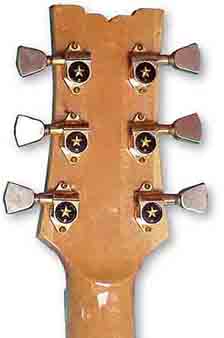 The
back of the peghead reveals the gold "star" tuners,
secured with top and bottom screws, that are common on high-end
Ibanez guitars of the period.
The
back of the peghead reveals the gold "star" tuners,
secured with top and bottom screws, that are common on high-end
Ibanez guitars of the period.
Because there is no serial number, it's impossible to calculate the exact year of manufacture for this guitar. But taking into account unique features like: the script-logo, early neck/heel joint and Ibanez embossed pickup covers, it could be as early as 1975. But anything is possible and this model was apparently available in '77-'78 because it was shown on a price list.
Years ago, I received sage advice from an experienced Ibanez collector: "If it's got a vine on the neck, buy it!" Apparently, Harold agrees with the philosophy. The 2672's ebony fretboard is inlaid with the distinctive MOP and abalone vine of life found on all the high-end models in the Professional series.
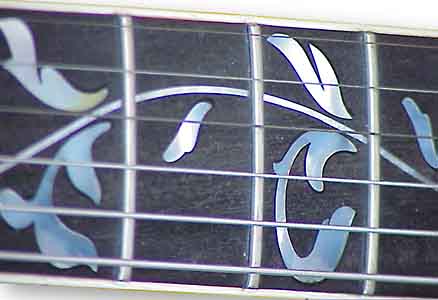
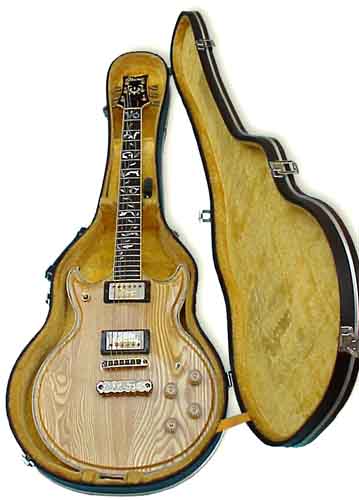 Maybe
you're thinking the same thing I am: "How could such a beautiful
guitar fade from the production line-up in just a few short years?"
Beats me! But, if this were not the case, we'd never have any
guitars that truly rose to the status of "rare."
Maybe
you're thinking the same thing I am: "How could such a beautiful
guitar fade from the production line-up in just a few short years?"
Beats me! But, if this were not the case, we'd never have any
guitars that truly rose to the status of "rare."
Ibanez Collectors World is very grateful to Harold for sending these fantastic pictures and giving us a glimpse at the "natural" beauty of the model 2672.
If you have an Ibanez guitar that you feel deserves to be showcased in the Guitar Tours section, drop us an email.
 Home Page | ICW Forum
Home Page | ICW Forum